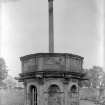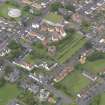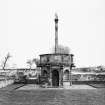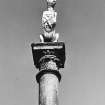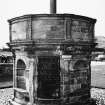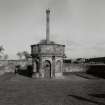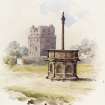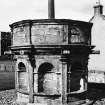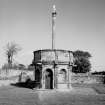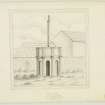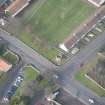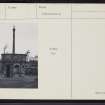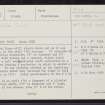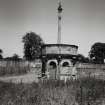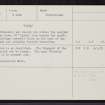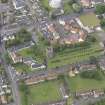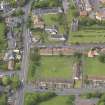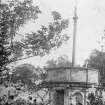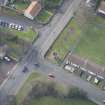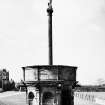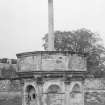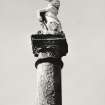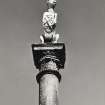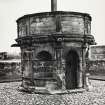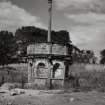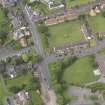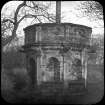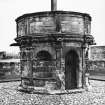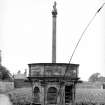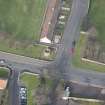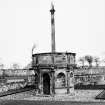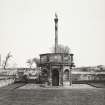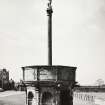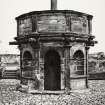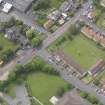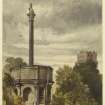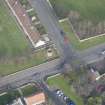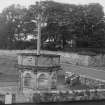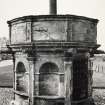Prestonpans, Preston Cross
Architectural Fragment (17th Century), Market Cross (17th Century)
Site Name Prestonpans, Preston Cross
Classification Architectural Fragment (17th Century), Market Cross (17th Century)
Alternative Name(s) Preston Mercat Cross
Canmore ID 53728
Site Number NT37SE 8
NGR NT 39156 74045
Datum OSGB36 - NGR
Permalink http://canmore.org.uk/site/53728
- Council East Lothian
- Parish Prestonpans
- Former Region Lothian
- Former District East Lothian
- Former County East Lothian
NT37SE 8 39156 74045
(NT 3915 7405) Cross (NR)
OS 6" map, (1966)
Preston Cross still stands where and as it was built, in the early 17th century. It consists of a circular structure, 14' in diameter and 12' high, with niches and a parapet, within which rises a tall oval sectioned shaft surmounted by a unicorn bearing a cartouche, on which is carved a lion. It was probably erected by the Hamiltons of Preston after they obtained the right to hold a fair in 1617.
There is an early 17th century fragment of a circular sandstone shaft, 2'2" in diameter and 3' high, built of two stones, some 30' E of the cross. Its workmanship and design are crude; the moulded circular base, 6 1/2" thick, lies beside the shaft.
The mouldings resemble those on the base of the cross and are probably derived therefrom.
RCAHMS 1924, visited 1919; V G Childe and W D Simpson 1954.
The cross is as described. The fragment of the shaft could not be found. The name 'Preston Cross' is in general use.
Visited by OS (RD) 4 January 1972.
NMRS REFERENCE:
PLANS:
For housing for E Lothian C.C.
Dick Peddie & MacKay, Edinburgh new
Bin 21, Bag 3 Dick Peddie, Todd & Jamieson
1937
Field Visit (18 June 1919)
This monument which dates from the early 17th century stands withinan enclosure some 400 yards north-east of Prestonpans station (Frontispiece). It consists of a drum of masonry, from which rises an oval sectioned shaft surmounted by a unicorn supporting a cartouche. The drum measures 14 feet in diameter across the parapet by 12 feet in height. It is divided vertically into eight panels or compartments by pilasters, above which a moulded architrave, frieze and cornice return round the structure; each compartment contains a niche with a semi- circular head; two of the niches form doorways, of which one leads to a small domically vaulted chamber at ground level, while from the other a narrow stair ascends to a platform at cornice level within the parapet. The other niches are semicircular on plan and are provided with sills forming seats, the heads being enriched to resemble a scallop shell.
A moulded base returns along the structure at ground level; the horizontal members all return at the pilaster projections. The pilasters have moulded capitals, and over each a moulded waterspout projects from the frieze; beneath each spout the architrave is enriched with guttæ.
The parapet encircles a walk or platform and is provided with a socket above every pilaster to hold a flagstaff. The shaft rises from a plinth and has a moulded necking, above which there is an acanthus ornament and a rectangular capital enriched with the egg-and-dart motif. The unicorn is crowned at the throat. The cartouche bears the lion rampant. The monument is in good preservation.
MOULDED AND CARVED DETAILS. Some 30 feet to the east of the Cross is a circular sandstone shaft 2 feet 2 inches in diameter and 3 feet in height, built in two stones. The upper portion displays in relief at four points of the perimeter an oval above a wreath. The workmanship and design are crude.
The moulded circular base, 6 ½ inches thick, lies beside the shaft. The mouldings resemble those of the base on the Cross and are probably derived therefrom. The fragment dates from the early 17th century.
RCAHMS 1924, visited 18 June 1919.
Publication Account (1985)
In medieval times the mercat cross indicated burgh status-a community established either as a royal burgh by the king or as a burgh of barony by secular or ecclesiastical vassals. Only stone crosses survive, though wood would also once have been used. The term 'cross' is less than accurate, however; most simply tapered to a simple head, often decorated, but not cruciform.
Preston cross, of yellow sandstone, has been described as the most handsome in Scotland. Dating to the early 17th century, probably to just after 1617 when Preston was granted a weekly market and annual fair, it is one of only two of its type surviving in Scotland and the only one in its original position.
The central shaft ends in a rectangular capital topped with a unicorn supporting a tablet carved with a lion rampant Below, the column is set in the rare and distinctive circular 'rotunda', some 4.3 m diameter by 3.7 m high. Six of the compartments, separated vertically by pilasters, have niches fitted with seats and semi-circular scallop-shell heads. The other two contain doorways-one leading to a small vaulted chamber; the other taking a narrow winding stair to the upper, crier's platform.
Preston, like the once separate coastal settlement of Salt Prieston/Prestonpans, was associated with the monks of New battle and Holyrood. From the later 14th century it belonged to a branch of the Hamilton family. Of interest nearby: the mainly 15th century Preston Tower with its 17th century, rectangular, 1000 bird, lectern-type doocot; a fragment of the 17th century Preston House; the 17th century two-storey
Hamilton House with its courtyard. A beehive-shaped 600 bird doocot not far from the mercat cross is probably 16th-17th century; it was associated with the late 16th-early 17th century Northfield House, an unfortified tower-house with turreted stairs (exteriors viewable).
Information from 'Exploring Scotland's Heritage: Lothian and Borders', (1985).































































